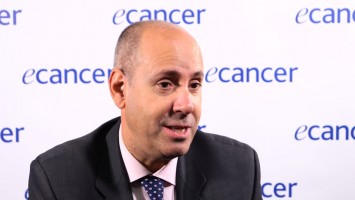SABCS 2012
HDAC inhibition sensitises triple-negative breast cancer cells to PARP inhibition
Dr Kapil Bhalla – University of Kansas Cancer Center, Kansas City, USA
Cancer cells, and breast cancer cells included, have DNA damage repair defects. So if you inflict DNA damage with chemotherapy or radiation therapy cancer cells are not as deft at repairing that DNA damage or undergo a DNA damage response and repair; as a result they often die more than normal cells. This has been the basis for our therapy for cancer and breast cancer for a long time. We’ve also learned that those breast cancers that have DNA damage repair defects based on mutations in repair enzymes, genes, such as BRCA1, BRCA2, ATM etc., they are particularly susceptible to agents that either inhibit additional default backup repair pathways, DNA damage repair pathways, or agents that induce a lot of DNA damage. So in the first category is the PARP inhibitor, an enzyme called PARP inhibitor which is involved in the backup default repair mechanism pathway, or cisplatin, for example. In triple-negative breast cancer it has been shown that even if the tumour doesn’t have BRCA1 or 2 mutation, PARP inhibitor and platinum is active against those tumours.
So what our laboratory has been working on is agents called histone deacetylase inhibitors and looking at heat shock proteins. You might ask why heat shock proteins are relevant here. Some of these DNA damage response and repair enzymes or proteins are kept in their active confirmation or their activity and stability is maintained by these heat shock proteins. So the concept was that can we, by using histone deacetylase inhibitors, affect the heat shock proteins in a manner that they would no longer chaperone or help fold into active confirmation these DNA damage response and repair proteins, thereby conferring a status on the triple-negative breast cancers a BRCAness, even though they don’t have BRCA1 mutation they would behave as if they have one. Then they would be susceptible, even more so, to PARP inhibitor or cisplatin. So essentially what we were trying to study is can histone deacetylase inhibitors modify the function of these heat shock proteins towards this DNA damage response repair proteins and confer a BRCAness so they become susceptible to PARP inhibitor or cisplatin. That would extend this kind of approach to a large number of triple-negative breast cancer patients who don’t have BRCA1 or 2.
What were the results?
We found that these histone deacetylase inhibitors, the pan-histone deacetylase inhibitors and one of them is already approved actually, FDA approved, but it’s approved for a certain type of cutaneous skin lymphoma, so that’s vorinostat, the other such similar, actually more potent, histone deacetylase inhibitors are undergoing clinical trials. So they’re out in the clinic, we know their dosages that are tolerated well and what side effects they have, etc. PARP inhibitors and cisplatin are also being studied in clinical trials, actually in combination in triple-negative breast cancers. So the idea of what this leads to is an immediate strong rationale to combine a histone deacetylase inhibitor with a PARP inhibitor or cisplatin, or maybe even all three, of course one would have to do it under a trial setting with fixed dosages of PARP inhibitor and cisplatin and then perhaps escalate the dose in cohorts of patients of the histone deacetylase inhibitor, find the right dose that’s safe and gauge the efficacy of this combination based on the mechanism we defined.
The other thing we found which was more a laboratory question was which histone deacetylase are these pan-HDAC inhibitors not inhibiting that induces the acetylation of heat shock proteins which makes them dysfunctional. By knock down experiments we found it was HDAC3 in the nucleus. Of course it’s known that it’s HDAC6 in the cytoplasm that these HDAC inhibitors inhibit to affect the heat shock protein function. So it’s a little scientifically convoluted but it’s pretty straightforward if you think that you’re conferring BRCAness by affecting a bunch of DNA damage response in proteins including BRCA1 and 2 that then confers BRCAness and greater sensitivity to PARP inhibitor and platinum in triple-negative breast cancer where we can’t use, right now, obviously, anti-oestrogens or HER2 targeted therapy.
Are there plans to start trials?
I will now hand the baton over to my clinical colleagues to design these trials and do them but there’s a great deal of interest. It would have to be done in a co-operative group setting or in an institution that sees a lot of triple-negative breast cancer patients and enrols them on trials. But that should not be very difficult.








